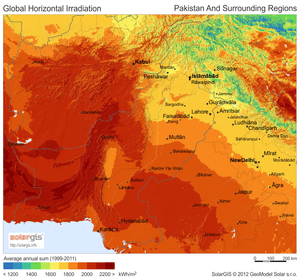Solar power in Pakistan
| Electricity generation in Pakistan |
|---|
 |

Pakistan has some of the highest values of insolation in the world, with eight to nine hours of sunshine per day, ideal climatic conditions for solar power generation. However, the country has been slow to adopt the technology.
The country has solar plants in Pakistani Kashmir, Punjab, Sindh and Balochistan. Initiatives are under development by the International Renewable Energy Agency, the Japan International Cooperation Agency, Chinese companies, and Pakistani private sector energy companies. The country aims to build the world's largest solar power park, the Quaid-e-Azam Solar Power Park (QASP) in the Cholistan Desert, Punjab, by 2017 with a 1 GW capacity. A plant of this size would be enough to power around 320,000 homes.[1]
Projects
Introduction of Clean Energy by Solar Electricity Generation System
On May 29, 2012, Pakistan inaugurated its first solar power on-grid power plant in Islamabad. Introduction of Clean Energy by Solar Electricity Generation System is a special grant aid project by the Japan International Cooperation Agency (JICA) under the Coolio Earth Partnership. This project includes the installation of two 178 kW photovoltaic (PV) systems at the premises of the Planning Commission and Pakistan Engineering Council.
This is the first on-grid solar PV project that employs net-metering, thereby allowing the beneficiaries to sell surplus electricity to the Islamabad Electric Supply Company (IESCO), the electricity distribution company of the Islamabad Division. The project was executed with grant assistance, worth 480 million Yen (approx. 553.63 million Pakistani Rupees) over three years commencing in 2010.[2]
Other projects
Beaconhouse installed the first high quality integrated solar energy system with a 10 kW power generation capacity capable of grid tie-in at Beaconhouse Canal Side Campus, Lahore. It was a pilot project for BSS designed by U.S. consultants, based upon feasibility by the U.S. Trade and Development Agency (USTDA).[3]
50 to 100 MW of photovoltaics is expected to be installed in 2013, and at least 300 MW in 2014.[4] In May 2015, 100 MW of a planned 1,000 MW were installed in the Quaid-e-Azam Solar Park.[5]
Annual solar irradiation
Solar irradiance in Pakistan is 5.3 kWh/m²/day.[6] Pakistan set a target to add approximately 10 GW of renewable capacity by 2030 in addition to replacing 5% diesel with biodiesel by 2015 and 10% by 2025.[7]
Photovoltaic installations
| Year | Installations in MWp | Notes | |
|---|---|---|---|
| Cumulative Capacity |
Added Capacity | ||
| 2014 | 400 | Calculated back from 2015 added capacity data.[8] | |
| 2015 | 1,000 | 600 | Preliminary data.[8] |
Government policy
Raja Pervaiz Ashraf, former Federal Minister of Water & Power announced on July 2, 2009 that 7,000 villages would be electrified using solar energy by 2014. Senior adviser Sardar Zulfiqar Khosa stated that the Punjab government would begin new projects aimed at power production through coal, solar energy and wind power; this would generate additional resources.[9]
The Government of Pakistan allowed the provincial government of Sindh to conduct feasibility research. The government planned to install a desalination plant powered by solar energy.[10]
See also
References
- ↑ Ebrahim, Zofeen T. (2015-09-08). "World's largest solar park to light up Pakistan's future". Retrieved 2016-08-04.
- ↑ Pakistan gets first on-grid solar power station
- ↑ "The Beaconhouse Times Online - Solar Panels Installed at Canal Side Campus". Tbt.beaconhouse.net. Retrieved 2014-06-13.
- ↑ Punjab, German firm ink solar energy MoU
- ↑ "Quaid-e-Azam Solar Park: Solar energy's 100MW to arrive in April". The Express Tribune. 27 March 2015.
- ↑ Potentials of Solar Thermal for Electricity use in Pakistan
- ↑ 7,000 villages to be electrified with solar power: Ashraf Archived 2009-07-08 at the Wayback Machine.
- 1 2 "International Energy Agency, A Snapshot of Global Photovoltaics Market 2015" (PDF).
- ↑ Dead link
- ↑ Dead link